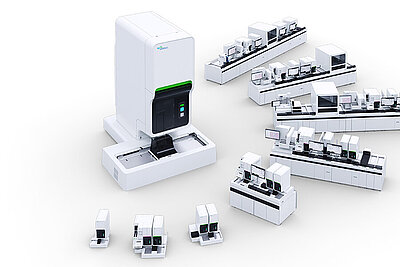Anaemia management
XTRA ARTICLE EDITION 2/2020
Patient blood management is a project close to Dr Stefanie Grützner’s heart. In this interview, the director of the Institute of Transfusion Medicine and Haemostaseology describes how Augsburg University Hospital implements this concept.
Interview with Dr Stefanie Grützner
Anaemia management helps us conserve blood supplies.
When did you start working with XN automation, and which optional applications are installed on the systems?
We have been working with it since late 2013 and have integrated three XN modules into the line. Two modules offer the RET channel with reticulocyte haemoglobin (RET-He) measurement. An additional module runs body fluids and fluorescence-marked platelets including the determination of IPF.
Why and how was the Patient Blood Management project implemented at Augsburg University Hospital?
Since blood supplies are dwindling and the population is ageing, it is important to reduce avoidable transfusions. To successfully implement patient blood management, we closely collaborated with the anaesthesia department to determine what can be done preoperatively and how blood draws, for instance, can be reduced. We then reduced the volume and frequency of blood draws and fundamentally changed our approach, so that we now need far fewer red blood cell concentrates.
So, how do you manage anaemia in line with the patient blood management concept at Augsburg University Hospital?
We focus on detecting and treating any existing anaemia in patients scheduled for elective surgery. For this purpose, we have established an anaesthesia outpatient clinic which patients visit to discuss premedication up to six weeks before surgery; in case of a particular constellation of baseline values, iron substitution is initiated. Even if less time is available preoperatively, a considerable effect can be achieved with intravenous iron therapy. At the initial visit, the focus is on the Hb level. If it is too low, an algorithm in our LIS automatically orders additional parameters, such as a subsequent reticulocyte count including RET-He, ferritin, transferrin, and transferrin saturation. This means that we initially analyse only the basics, but we can order more tests without requiring another patient visit. From the anaesthesiologist’s perspective, likewise, it is easier to push the button for more testing without having to take the time to pick out the correct parameters. Then, the patient is asked to return for iron substitution therapy.

In your opinion, what is the advantage of using the RET-He parameter versus conventional markers in anaemia diagnostics?
With RET-He, I am independent of the acute-phase situation, which is important in many orthopaedic surgeries as well as in cancer, of course. The second important point is that RET-He detects iron deficiency at a very early stage. After all, it is based on reticulocytes, the precursors of mature red blood cells, which reflect the situation of the past week. Additionally, RET-He is optimally suited for follow-up monitoring. Following intravenous iron administration, the RET-He level rises after only three to five days and therefore shows relatively quickly whether treatment is effective. Depending on how low the level is, ferritin simply takes longer, of course. I can see a response to intravenous iron administration first in RET-He, before the Hb levels ever rise. Reticulocytes are of interest in any patient receiving iron substitution therapy, and we never do a reticulocyte count without RET-He. Another advantage is the fact that RET-He can be measured using the existing blood count vial.
In which areas can RET-He replace other clinical chemistry markers?
The parameters needed always depend on the clinical question. That is, are they needed for treatment monitoring or for iron deficiency testing? For treatment monitoring, there is no need to continually check all parameters, and we can absolutely make do with RET-He. To assess the entire iron status, however, ferritin is needed.
So, who continues the monitoring after surgery?
That is a sore point. If the patient is discharged relatively soon after surgery, we are faced with a collaboration between outpatient and inpatient structures, which is difficult. It would certainly be desirable for the primary care physician to continue monitoring the RET-He.
Photo source: Augsburg University Hospital



